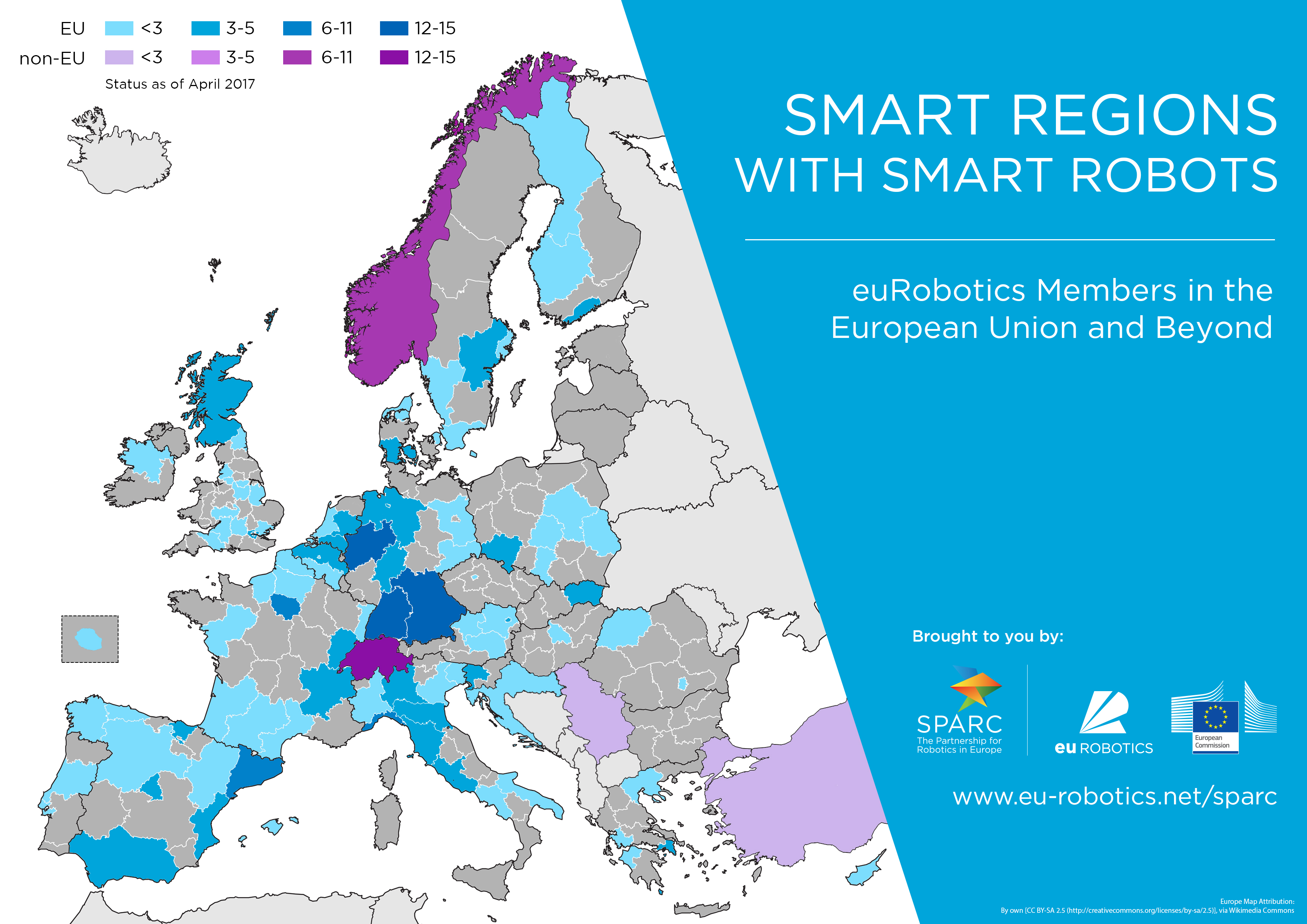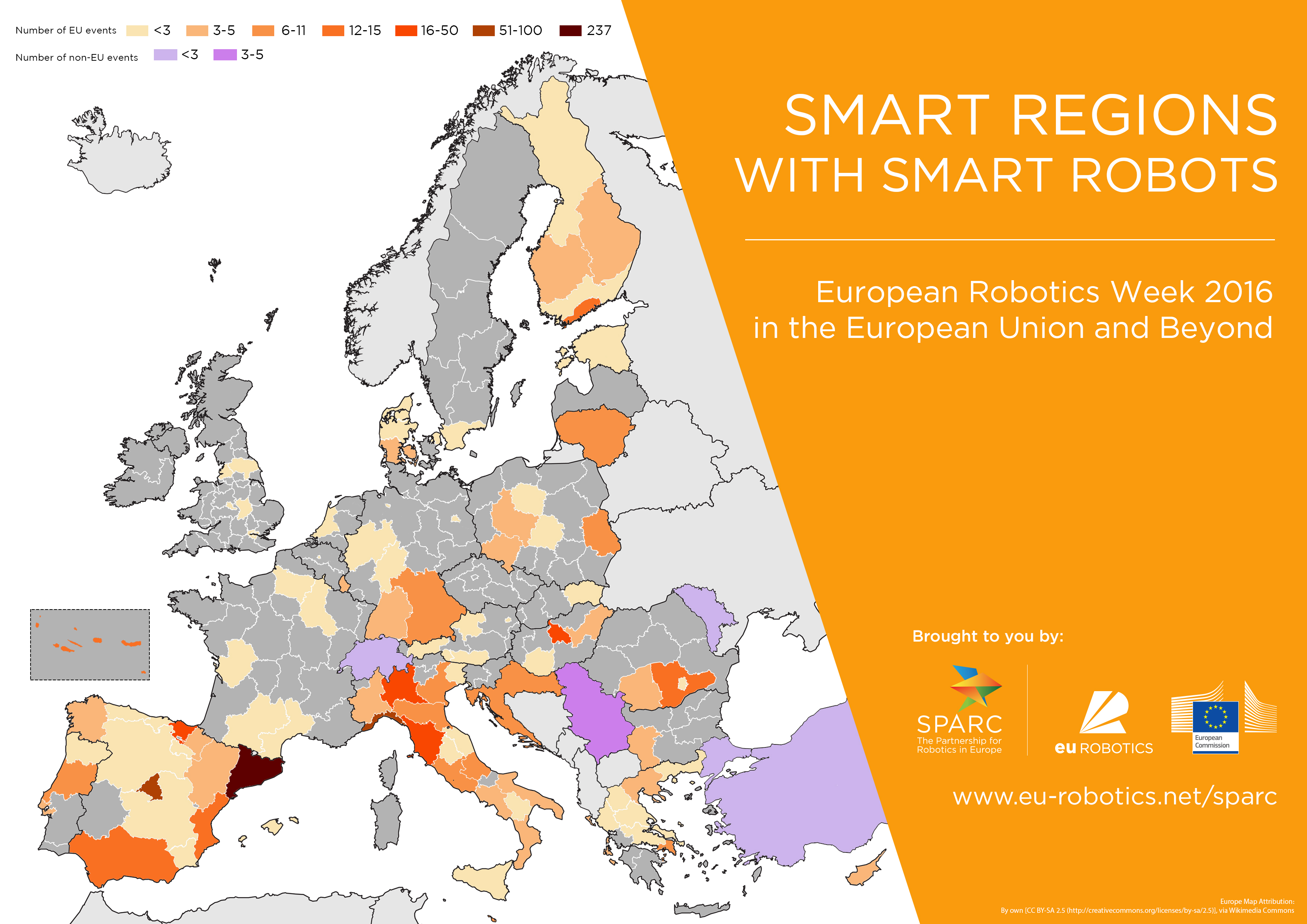Regional Innovation Centres as part of European projects
The European Union has offered a wide variety of opportunities for regions to develop robotics, under the current EU Research and Innovation programme Horizon 2020 (H2020), and under FP7, the previous Research and Innovation funding programme for 2007-2013.
One FP7 initiative is the robotics research project the European Coordination Hub for Open Robotics Development (ECHORD++). ECHORD++ promotes interaction between robot manufacturers, researchers and users, through instruments such as the Robotics Innovation Facilities (RIFs), robotics labs where companies can test their ideas in life-like scenarios. RIFs are inclusive: they accept applications from any company, institution or research organisation, even if they have no robotics experience.
One RIF is based in the Bristol Robotics Laboratory (BRL), which is a partnership between the University of the West of England, Bristol and the University of Bristol and the largest academic centre for multi-disciplinary robotics research in the UK. The state-of-the-art laboratory covers an area of over 3,000m2, and is equipped with robots, vision systems, etc. One of Europe's largest indoor arenas for flying miniature unmanned aerial vehicles is located within BRL.
Watch a presentation of the RIF@Bristol:
The Interactive Robotics Laboratory RIF of France's Atomic Energy and Alternative Energies Commission (CEA) has 80-120 researchers focusing on service robotics, remote handling and collaborative robotics, with applications in energy (nuclear, oil and gas), industry and health (surgery and rehabilitation). The Interactive Robotics Laboratory also works on service robotics, with a focus on personal assistance requiring dexterity, mobility and autonomy (intelligent systems). The laboratory provides technological innovation and develops industrial prototypes.
Watch the presentation of the RIF@Paris:
Tuscany is Italy's third most important region for industrial robotics, with more than 83 firms with an average annual turnover of €5.5m. The Peccioli RIF supports research, teaching and innovation institutions in Pisa, Florence and Sienna and their 300 or so spin-off companies. The RIF has outdoor and indoor settings, where systems can be developed and tested, including robotic workers, robot companions in the home and in nursing homes, and logistics, edutainment, agricultural and medical robotics.
Watch the presentation of the RIF@Peccioli:
Another tool at the disposal of EU regions is EuRoC ─ shared facilities for tackling common challenges, funded under the I4MS initiative. EuRoC consists of three challenges: whole manufacturing supply chains within production; logistics; and servicing. It promotes technology transfer from academia to industry.
Other digital innovation hubs funded under the I4MS initiative are: the Lithuanian Robotics Association; the Serbian Manufacturing Innovation Hub; the Croatian Robotics Digital Innovation Hub (CROBOHUB); the Digital Innovation Hub iAsturias 4.0; and CREATE in Naples, Italy.
H2020 finances ROBOTT-NET, a project driven by four national research technology organisations in Denmark, Germany, Spain and the United Kingdom which joined forces to develop business ideas based on innovative robot technology. The goal of ROBOTT-NET is to shorten the path to market for new robotics technologies, increase the competitiveness of Europe’s manufacturing sector and create new business opportunities for industrial and service robotics.
Watch the presentation of ROBOTT-NET:
Another project financed under Horizon2020 is HORSE, which aims to set up regional Centres of Competence, acting as clustering points for manufacturing applications. HORSE has equipped and set up from existing facilities three centres of competence; in France at CEA Paris-Saclay, in Germany at the Technical University of Munich, and in The Netherlands at TNO Delft. A Slovenian Competence Centre on Robotics related to human-robot co-manipulation will also be established.
Furthermore, in Slovenia’s Smart Specialisation Strategy, robotics is identified as one of the key enabling technologies to support the country’s aim to increase exports of automated industrial systems and equipment by at least 25% by 2023.
Slovenia’s Jožef Stefan Institute (IJS) is also part of the European project ReconCell, which is developing a new type of easily reconfigurable robot work-cell, to allow SMEs to benefit from robotic automation. The project is a pan-European collaboration between research institutes and private companies.
Slovenia has been an inspiring model for a robotics strategy for the whole Balkan countries area. The European Robotics Forum 2016 in Ljubljana, Slovenia emphasised that Europe should not be divided into some regions with high-tech industries, high employment rates and wealth, and others with mostly manual labour, low wages, and high unemployment. Hence, the European Union needs a strategy to develop a successful robotics industry and its academic partners at the periphery of Europe.
A robotics hub has already been developed in Belgrade, Serbia with I4MS funding. Part of this project is to develop a strategy for creating a sustainable centre where researchers and industry can identify potential local industrial activities in robotics. The regional chamber of commerce and governmental agencies have identified this initiative as of great importance for the economy.
Read more about the Balkan regions and robotics (European Robotics Forum 2016)
Join the events organised under SPARC – the robotics PPP
euRobotics is a non-profit organisation based in Brussels with the objective to make robotics beneficial for Europe's economy and society. With more than 250 member organisations, euRobotics also provides the European Robotics Community with a legal entity to engage in a public/private partnership with the European Commission, named SPARC.
SPARC, the public-private partnership (PPP) between the European Commission and euRobotics, is an initiative to maintain and extend Europe’s leadership in civilian robotics. Its aim is to strategically position European robotics in the world, thereby securing major benefits for the European economy and society at large.
SPARC is the largest civilian robotics research and innovation programme in the world, with €700 million in funding from the European Commission from 2014 to 2020 and triple that from European industry, to yield a total investment of €2.8 billion. SPARC will stimulate a more vibrant and effective robotics community that collaborates in development and commercial exploitation in all regions.

Two yearly events, involving the robotics community across all the regions in the EU and beyond, are organised under SPARC ─ the European Robotics Forum (ERF) and the European Robotics Week (ERW).
The European Robotics Forum ─ after its start in San Sebastian in 2010, this annual event has quickly become the most influential meeting of the European robotics community. Over 800 researchers, engineers, managers, and a growing number of entrepreneurs and business people from all over Europe come together to discuss robotics, which has an immediate impact on the roadmapping process for robotics in Europe. Funding for developing robotics in European regions, success stories of FP7 and Horizon2020 projects, digital European strategy and artificial intelligence are at the heart of the forum debates.
The European Robotics Week ─ this week of robotics-related activities across Europe for the general public highlights the growing importance of robotics in a wide variety of areas. The week was conceived at ERF 2011 as a result of the desire of the European robotics community to bring robotics research and development closer to the public. The activity-packed European Robotics Week includes: robotics lectures in schools; guided tours of research centres for pupils; laboratory open days; exhibitions; challenges; and public demonstrations of robots. In 2016 there were more than 800 events across the regions of Europe.

Through all these initiatives, the ultimate goal is to create a network of research and innovation hubs in all European regions, so that any company in Europe will have local access to the competence needed to digitise its production, products or services, in order to improve competitiveness, efficiency and quality and benefit in other ways from robotics technologies.
Read Part 1 - Regional Robotics Clusters and innovation agencies – best practices